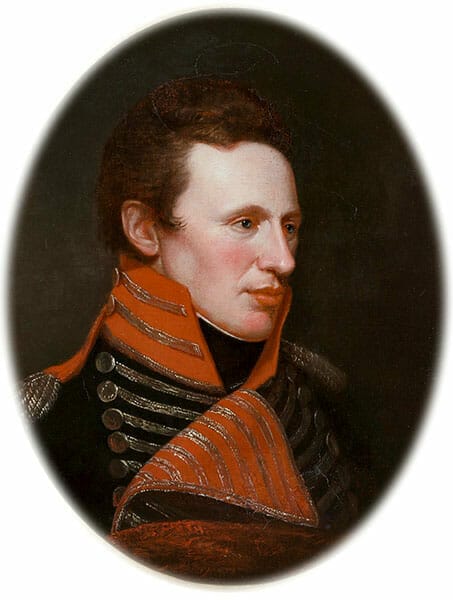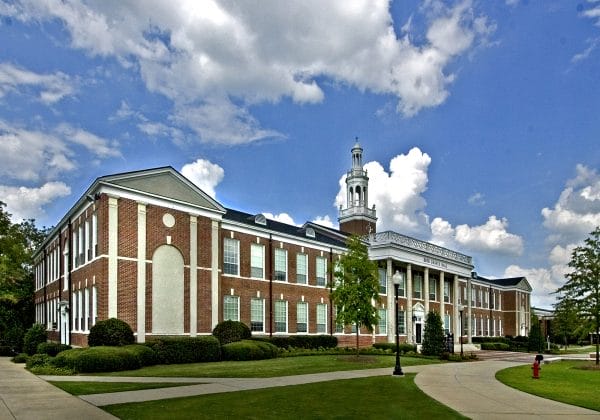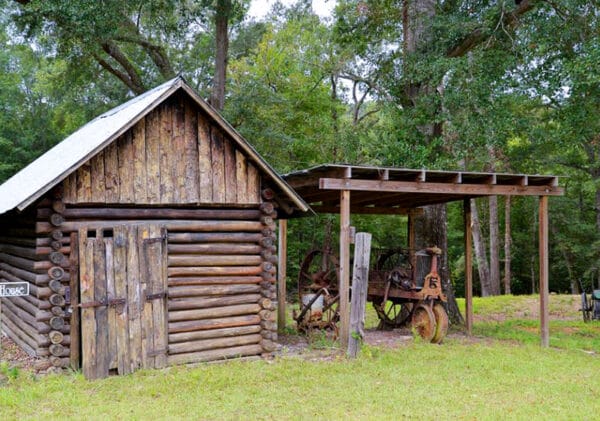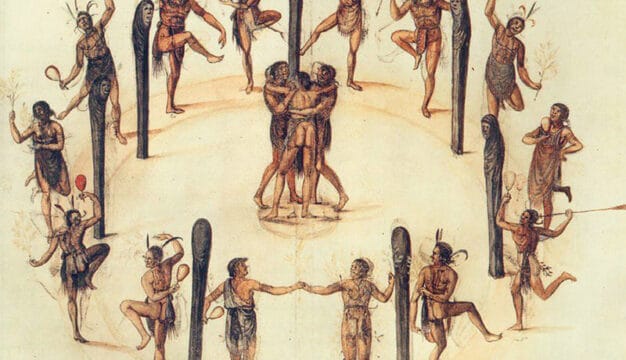Troy
 Trojan Statue at Troy University
The city of Troy is the county seat and the largest town in Pike County. From its origins as a small rural settlement, Troy has grown into a thriving college town as the home of Troy University. Troy operates under a mayor-council form of government. The mayor serves and is elected at-large, and the five council members serve single-member districts.
Trojan Statue at Troy University
The city of Troy is the county seat and the largest town in Pike County. From its origins as a small rural settlement, Troy has grown into a thriving college town as the home of Troy University. Troy operates under a mayor-council form of government. The mayor serves and is elected at-large, and the five council members serve single-member districts.
Douglas Edwards, CBS television news’ first anchor person, was raised in Troy. Adm. Henry Wiley, chief operational officer and highest-ranking officer in the U.S. Navy in the late 1930s was born in Troy, as was Clarence “Pinetop” Smith, the inventor of boogie woogie music, artist Fred “Nall” Hollis, and Patricia Schubert Barnes, founder of Sister Schubert’s baked goods.
History
 Zebulon Montgomery Pike
Once part of territory belonging to the Creek Indians, the land that would become Troy was first settled in the early 1830s. Known as Deer Stand Hill at this time, its first recorded white settler was William Soles in 1835. Subsequent settlers established textile mills and began raising cattle. Three Notch Road, originally a Creek hunting trail to Tennessee, became an official road in 1824 and was used as a trade route to Pensacola. In 1838, the owners of Deer Stand Hill, John Hanchey and John Coskrey, succeeded in having the county seat moved from Monticello to their property, a more central location in the county, and Troy was thus founded.
Zebulon Montgomery Pike
Once part of territory belonging to the Creek Indians, the land that would become Troy was first settled in the early 1830s. Known as Deer Stand Hill at this time, its first recorded white settler was William Soles in 1835. Subsequent settlers established textile mills and began raising cattle. Three Notch Road, originally a Creek hunting trail to Tennessee, became an official road in 1824 and was used as a trade route to Pensacola. In 1838, the owners of Deer Stand Hill, John Hanchey and John Coskrey, succeeded in having the county seat moved from Monticello to their property, a more central location in the county, and Troy was thus founded.
Formerly known as Zebulon and Centreville, the town was first called Troy on October 9, 1838, in a deed recorded by Luke R. Simmons, Pike County’s state representative in the Alabama legislature. One account says that Simmons, a native North Carolinian, named Troy in honor of Alexander Troy, once attorney general of North Carolina. Simmons explained this choice while talking with Gov. Thomas Watts of Alabama and the governor‘s son-in-law Col. Daniel S. Troy, son of Alexander Troy. Other accounts, however, say that a man from Troy, New York, suggested the name of his hometown because it was easier to say and spell than both of the previous names.
In 1839, the first Troy courthouse was built of wood in the center of the new town square by Nubel A. Moore. One of the first buildings to be constructed after the courthouse was a jail, indicative of the frontier nature of the town. On February 4, 1843, Troy was officially incorporated, and this is the date that the town has chosen to observe as its birth date.
 Curbside Market in Troy
The first mercantile enterprise in Troy was begun in the 1840s by James M. Thompson and Stephen D. Smiley, who ran a general merchandise store. A grocery and several taverns followed. A congressional act in 1842 established Troy as a Federal Post Office, and at least two post roads served it at the time. Troy’s population was small at the outbreak of the Civil War in April 1861, but by 1863 John P. Amerine was able to organize enough men to form the Fifty-seventh Alabama Infantry Regiment in the city. The Troy Messenger, a daily newspaper, was established in 1866 and is one of the oldest newspapers in the state.
Curbside Market in Troy
The first mercantile enterprise in Troy was begun in the 1840s by James M. Thompson and Stephen D. Smiley, who ran a general merchandise store. A grocery and several taverns followed. A congressional act in 1842 established Troy as a Federal Post Office, and at least two post roads served it at the time. Troy’s population was small at the outbreak of the Civil War in April 1861, but by 1863 John P. Amerine was able to organize enough men to form the Fifty-seventh Alabama Infantry Regiment in the city. The Troy Messenger, a daily newspaper, was established in 1866 and is one of the oldest newspapers in the state.
Troy’s greatest growth took place in the 1870s, when Urban Louis Jones, Troy’s first recorded mayor, paid the Mobile and Girard Railway, now the Central of Georgia, to extend its railroad from Columbus, Georgia, to Troy, making Troy the center of trade for several counties. Before the railroad extension, Troy’s population was less than 500; after the railroad was completed, the population increased to 3,000 within 10 years. In 1892, a second railway, the Atlantic Coast Line, was completed, connecting Bainbridge, Georgia, to Montgomery by way of Troy. Another factor in Troy’s growth was the establishment of a state teacher’s college in 1887; the school later would become Troy University.
Those involved in the local civil rights movement in Troy initially were interested in expanding job opportunities for Africans Americans. The Troy City School Board offered voluntary school integration in 1965 as an appeasement. After Alabama District Judge Frank M. Johnson Jr. ordered mandatory desegregation for city schools in 1971, all Troy city schools were integrated. Alphonso Byrd (one of the first black teachers at Charles Henderson High School) and Johnnie Mae Warren became the first African American members of the Troy City Council in 1985 after the city changed to a mayor-council form of government in response to the threat of an anti-discrimination lawsuit.
Demographics
According to 2020 Census estimates, Troy’s population was 18,995. Of that number, 55.9 percent reported themselves as white, 38.9 percent as African American, 3.6 percent as Asian, 1.2 percent as two or more races, 1.4 percent as Hispanic or Latino, and 0.3 percent as American Indian. The city’s median household income was $34,603, and per capita income was $24,864.
Employment
According to 2020 Census estimates, the workforce in Troy was divided among the following industrial categories:
- Educational services, and health care and social assistance (28.2 percent)
- Retail trade (15.7 percent)
- Arts, entertainment, recreation, accommodation, and food services (12.2 percent)
- Transportation and warehousing and utilities (8.9 percent)
- Manufacturing (8.6 percent)
- Professional, scientific, management, and administrative and waste management services (8.4 percent)
- Public administration (5.0 percent)
- Other services, except public administration (3.7 percent)
- Finance, insurance, and real estate, rental, and leasing (2.6 percent)
- Construction (2.1 percent)
- Wholesale trade (1.7 percent)
- Information (1.5 percent)
- Agriculture, forestry, fishing and hunting, and extractive (1.4 percent)
Transportation
Troy is served by U.S. Highway 231 and U.S. Highway 29. The Conecuh Valley Railroad runs from Troy to Goshen.
Education
 Troy University
The Troy Public School System has one high school, one middle school, one elementary school, and an alternative learning center. The Troy-Pike Regional Center for Technology provides vocational training. There is also one private K-12 school. Troy is also home to Troy University, a public institution of higher education that was founded in 1887 with campuses in several other Alabama cities.
Troy University
The Troy Public School System has one high school, one middle school, one elementary school, and an alternative learning center. The Troy-Pike Regional Center for Technology provides vocational training. There is also one private K-12 school. Troy is also home to Troy University, a public institution of higher education that was founded in 1887 with campuses in several other Alabama cities.
Events and Places of Interest
 Pioneer Museum Smokehouse
The Troy University Arboretum is a botanical garden and nature preserve located next to the Troy University main campus. It includes more than 300 different species of trees, as well as a 2.5-mile nature trail with a swamp, stream, and pond. Other places of interest include the Town Square Confederate Memorial Monument, the Johnson Center for the Arts, the Pioneer Museum of Alabama, the Pike County Lake Troy Recreation Center, the Bicentennial Park, and the Trojan Oaks Golf Course. Troy is host to the annual TroyFest, held in honor of local artist Jean T. Lake. This festival, which celebrates fine art and crafts, draws nearly 10,000 people to downtown Troy.
Pioneer Museum Smokehouse
The Troy University Arboretum is a botanical garden and nature preserve located next to the Troy University main campus. It includes more than 300 different species of trees, as well as a 2.5-mile nature trail with a swamp, stream, and pond. Other places of interest include the Town Square Confederate Memorial Monument, the Johnson Center for the Arts, the Pioneer Museum of Alabama, the Pike County Lake Troy Recreation Center, the Bicentennial Park, and the Trojan Oaks Golf Course. Troy is host to the annual TroyFest, held in honor of local artist Jean T. Lake. This festival, which celebrates fine art and crafts, draws nearly 10,000 people to downtown Troy.
Additional Resources
Farmer, Margaret Pace. History of Pike County, Alabama. Troy, Ala.: s.n., 1952.
———. One Hundred Fifty Years in Pike County, Alabama, 1821-1971. Anniston, Ala.: Higginbotham, Inc., 1973.
Richardson, Jesse M., ed. “Troy” in Alabama Encyclopedia. Northport, Ala.: American Southern Publishing Company, 1965.



